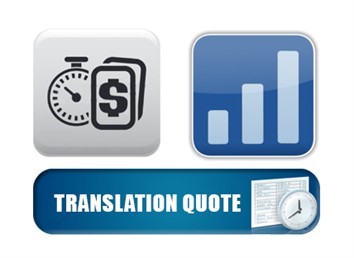Audio/Video Translations: Preparing a Translation Budget
Some of you may have already prepared your translation budgets for 2014, but I thought I would blog a little refresher and reminder on the importance of budgeting for translations.
My past blog series on topic should still be very helpful and you can read those at:
- How to create a quote for document translation services
- How to create a quote for software translation services
- How to create a quote for website translation services
In addition, GPI’s Translation Portal has two handy tools to help you scope translation projects for documentation and for preparing budgets. You can access these free tools at translationportal.com.
This year many of you will be responsible for managing a translation project for your company. You might have audio/video translation, document translation, SEO translation, software translation, and/or website translation projects to complete. This first blog in the series will cover audio/video translation project preparation and quoting including:
- How to prepare your audio/video files (localization kit) for translation?
- How to create a translation budget or get a quote?

Some general questions on audio/video translation projects
When preparing your audio/video translation project you need to collect some basic information in addition to your source assets and files. Regarding the translation part of the project you will need to answer the following questions:
- What languages do you need?
- What are the regions (locales)?
Do you employ any native speakers of the target languages with knowledge of your products/services? These people can help you and/or your translation company or studio review the scripts, recorded audio and final video for translation accuracy.
- Do you have any specific script guidelines?
- Have you translated any documentation before?
- Did you use translation memory when completing the translations?
- Are there any reference materials available or any past translations your audio/video studio or translation team can review (Demos, Training Sessions, White Papers, Glossaries)?
Regarding the audio/video production part of the project you will need to answer the following questions:
- What type of source files/formats will you be using? I.e. MOV, .MPG, .WMV, .RM?
- In what format would you like to receive the localized versions?
- How many talents (voices/actors) are required for the audio/video translation?
- What are the genders required?
- Do you have someone available who will be able to listen to and select voice talents in the languages requiring voice over?
- How is the current English video recorded? Are you using separate tracks for voice and background or a single track?
- What type of voices are needed (common cord, informal, traditional for advertisement, traditional for institutional training)?
- What is the word count of the scripts and/or the run time of the videos?
- Are there any pronunciation guidelines regarding names, numbers and acronyms?
- What are the preferred output methods and deliverables?
- Do you require subtitling?
- Will you require any post-production assistance?
- Are there any additional duplication and/or shipping requirements?
- Will you be providing the transcriptions/timed scripts?
Once you determine the above you are ready to prepare your source files for translation quoting and begin your project.
Preparing your audio/video files (“localization kit”)
In the translation business we call the set of files that you put together to scope and complete a translation project a “localization kit”. These are simply all the source files needed to accurately quote and translate or “localize” your project into another language. For an audio/video translation project those files should include:
All source files, both assets and authoring programs in their native formats including:
- Tapes, VHS for videos
- Timed scripts
- Audio files (.WAV, .MP3, .WMA, .M4A, .MIDI, .OGG, etc.)
- Multimedia authoring files such as Captivate, Articulate etc.
Reference material including:
- Glossaries
- Past translations
- Style guides
- Pronunciation guidelines
- Any previous Translation Memories.
- See what is a translation memory (TM)?
- Any written scripts, if available

After you collect the required source files your studio, translation team or translation company would analyze the audio/video localization kit for:
- Number of words in the script
- Languages requested
- Subject matter
- Voice and video talents (voices/actors)
- Gender (male or female)
- Type of voice and tone (i.e. formal, young, older, energetic, serious, etc.)
- Desktop publishing requirements for any graphics
- Multimedia requirements for authoring design and development
- Source and target file formats required
- Client review and approval requirements
- Client workflow requirements
After the analysis is complete a comprehensive quotation packet can be provided with all tasks, costs and timelines required to complete the project.
Preparing your audio/video budget or quote
A typical audio/video translation project may include the below line items. There are prices per word and per hour that will be applied depending on the tasks as well as metrics for studio and talent time and costs. The quote/budget should look like the below:
Audio/Video Quote:
| Tasks | QTY | UNIT | RATE | Item Total | Total |
| Translation of script1 | 1440 | words | $.20 | $288.00 | |
| Studio Time2 | 4 | hours | $200.00 | $800.00 | |
| Voice Talent Time3 | 4 | hours | $250.00 | $1000.00 | |
| Multimedia Authoring4 | 3 | hours | $75.00 | $225.00 | |
| Subtotal | $2313.00 | ||||
| Project Management (10%) | $231.30 | ||||
| Total | $2544.30 | ||||
Translation-copywriting and proofing of the script price depends on languages and subject matter expertise required.
Time required in studio for recording, video, editing and pre-post production.
Voice talent recording time. May vary depending on any minimums like ½ days or full days and/or if voice coaches are required for recording.
Providing multimedia localization services for video, audio, and graphic files.
With all of your source file packages and an accurate quotation to complete the work, you should now be able to reliably complete your audio/video translation project.
